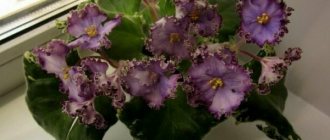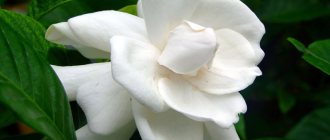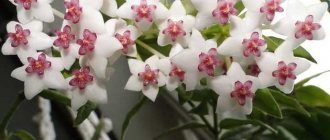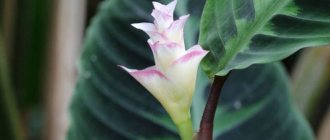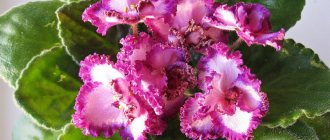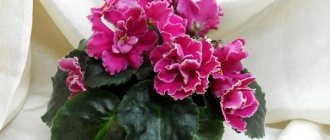A huge soft lavender star with large blue fantasy and white fringe. Compact dark rosette, abundant and frequent flowering.
A huge soft lavender star with large blue fantasy and white fringe. Compact dark rosette, abundant and frequent flowering.
Uzambara violet.
Family Gesneriaceae - Gesneriaceae.
Genus Saintpaulia hybrida - Hybrid Saintpaulia.
African violet saintpaulia hybrid.
Violets from breeders of the CIS countries - “P-2”.
Proshka (Frolov).
Large soft lavender star with large blue fantasy and wide white fringe.
Simple medium green quilted foliage. Standard. Compact, quite neat socket.
Delicate fantasy flowers, when you try to pull the flowers out from under the leaves, they simply tear. The flowers have an expressive white fringe. The color of the flower is different, each bloom is different from the previous one.
The variety is very generous in flowering, blooms almost constantly. Even in the first flowering it shows a cap. There are many buds, each peduncle has 7-8 buds. This variety probably needs to remove some of the buds because... they grow in such numbers that they bloom in two layers - an upper layer and a layer underneath, which is almost invisible.
Problem-free, easy to propagate. The sport is simply a solid dark blue or pink color.
Prokhor (from ancient Greek “the one who is in front of the choir”) is a male name of Greek origin. Proshka is a diminutive name.
Do you know that…?
Adult violets lack juvenile leaves. The leaf petioles are thicker, the leaf blades are larger. Their color is more saturated and dark. If the leaves are quilted, then their surface becomes simply bumpy. With age they become less elastic. The stem diameter of such plants is 1.3-1.5 times larger than that of young ones. In mature plants, the tendency to shoot shoots sharply decreases. But the fundamental difference between an adult and a young violet is the quality of flowering. Mature specimens have larger flowers, many peduncles and they are more durable, and there are also many more flowers. Double varieties have double flowers, rather than single or semi-double, which is often observed in young plants. Wide white edges and a richly corrugated edge are clearly visible.
Caring for a plant at home
Most Nadezhda Dmitrievna varieties require slightly special conditions for their cultivation.
Conditions of detention
The created conditions for your flower will allow you to see the desired flower in it . With rosette, coloring and peduncles:
- Determine a suitable location;
- Choose small pots with suitable soil composition;
- Provide good lighting;
- Temperature and humidity must be optimal;
- Water promptly. And in the most convenient way;
- Regularly replant the plant;
- Carry out prevention against diseases and pests.
Proper watering and fertilizing
The condition of the violet is largely determined by watering . And its dimensions:
- Select the watering mode and methods And places: The condition of the soil will always indicate the need for watering. As soon as the top layer dries;
- Methods: In a pallet;
- Using a wick;
- Watering can with a narrow spout. She's comfortable. So that water does not get into the growing point and on the flowers.
Top watering of violets.
mineral complex fertilizers sparingly. They contribute to the growth of foliage in violets and the formation of buds:
- During the growing season, fertilize 2 times a month;
- During the rest period they are not required.
Important! With wick irrigation, the rosette sizes are larger than other methods. They grow up to half mini. And bigger.
Lighting and temperature
Violet Adam does not have any special lighting requirements . Common in many varieties. The color does not change due to temperature changes:
- Choose non-southern window sills . If there is such a possibility. In summer time. In winter, they have different conditions: They require lighting for about 12 hours ;
- During winter periods, additional lighting will be required . They will lack natural color at this time;
- On shelves and racks away from windows there is no way to do without it;
- Provide protection from direct sunlight : Curtains;
- Blinds;
- Curtains;
- Parchment paper also works.
Maintaining optimal temperature affects the formation of rosettes and buds:
- 26 degrees is no longer comfortable for violets;
- 21-25 degrees is optimal for them;
- In winter, even 16 degrees is enough.
Air humidity
Dry air will not promote good flowering. Under natural conditions, these violets grow near rivers and waterfalls.
Violets do not like dry air.
Heating radiators can significantly dry out the air. Installing trays and containers with water near the flowers will help to moisten it. Flower growers use moistened foam sponges and expanded clay.
Important! Spray the air near flowers and shelves with a spray bottle.
What kind of soil does he prefer?
For miniature varieties of violets, choose soils that allow moisture and air to pass through well . And with a set of microelements.
Specialized stores offer various soil compositions for Saintpaulias. This is convenient for beginner gardeners. And experienced flower growers do not refuse them. They use it as the basis for preparing their soil. Which should contain:
- Turf and leaf soil;
- High peat;
- Sphagnum moss;
- Coarse sand;
- Vermiculite.
The soil loses its quality within 9-12 months . Even with supplements.
Select a pot taking into account the size of the rosette and the mini variety. It will only need 6 cm .
Pruning and hygiene
In order for the plant to maintain a neat rosette of flowers:
- Remove dried flower stalks in a timely manner ;
- Cut off the lower yellowed leaves;
- When replanting, carefully inspect the roots . And remove the dried and diseased ones;
- Control the appearance of stepchildren and children : You can remove rosettes and form new buds to preserve the beauty;
- Use babies for reproduction.
Stepson.
Reproduction methods
The variety is very easy to propagate. Many gardeners think so:
- The easiest and most reliable way is using cuttings ;
- Children will allow you to grow flowering plants even faster;
- Few people propagate by seeds
Transplant rules, rejuvenation
Experts recommend replanting violets at least once a year . It's better to do this in the spring.
The reasons may be different:
- Soil acidification and the need to replace it;
- After purchasing in a store. Taking into account the condition of the plant;
- The plant has grown and its roots are wrapped around the earthen ball.
Transplant sequence:
- Water the plant lightly;
- Select and prepare a pot (if necessary);
- Lay drainage and soil;
- Remove the plant from the pot and prepare the roots. Maybe you need to wash the roots;
- Plant the plant. Add soil to the top edge of the pot.
Transplant methods:
- Transshipment;
- With partial replacement of soil;
- With complete replacement of soil.
Important! Do not replant plants when flowering. Only in urgent cases!
Features of flowering, growth and reproduction
The color of the flowers is the most discussed in this variety.
Development at home
The development of the variety is interesting to observe. The violet variety Adam is in no hurry to bloom . This is what irritates impatient violet lovers a little. They compare it with other varieties:
- The buds at the beginning of flowering are almost green . It takes quite a long time to open. And even having blossomed a little, they can remain in this state for a long time;
- Blueness appears later . When they already take the shape of a rose;
- Beautiful flowers are not so large when they first bloom;
- With further cycles, their sizes increase noticeably . Especially after the third one.
How long does it take to grow an adult plant?
From the moment the children are seated until the contemplation of the beautiful flowers blooming, it takes at least 10-12 months.
You yourself can reduce these periods a little with good care.
How are varietal characteristics transmitted?
Propagating the variety is not particularly difficult. For those who have ever done this with other varieties. To propagate this variety, a vegetative method is used:
- Rooting leaf cuttings;
- Seating the children.
Few people propagate by seeds. But it is possible. Only the process is more complex and lengthy.
Flowering in hot and cool conditions
The first flowering is not so full. Subsequent blooms are more impressive. They just show the real coloring of the variety. After all, a characteristic greenish color appears.
For 6-7 months, the flowers retain their attractive appearance and freshness . They only turn green towards the end of flowering. Like hydrangea.
What do flower stalks look like?
- Strong and short peduncles of varying lengths often form 3 buds on each;
- On longer peduncles, flowers bloom almost twice as slow. Than on short ones.
Is it possible to achieve cap flowering?
A cap of smoky blue-blue flowers can form even during the first flowering :
- Each flowering may be different from the previous one. Even strongly;
- Green tones can be stronger or weaker. Otherwise it will disappear completely;
- And on one rosette you can observe white-green and bluish-green flowers. Greenery can come and go;
- The sizes of flowers are not always the same. There are also large ones. And small, inconspicuous ones. Simultaneously.
Bud lifespan
- Flowering is abundant and long lasting . And often they bloom;
- Old flowers fade and turn green. And at the same time, young buds appear in the center. They are replaced.
Important! A single flower maintains an attractive appearance for up to 2 months.
Violet SK-Landscape in the fog (A. Kuznetsov)
Fairytale violet SK-Landscape in the fog.
SK-Landscape in Fog is an indoor, miniature violet, from the genus of hybrid Saintpaulias , the Gesneriev family. The variety was bred by breeder A. Kuznetsov, named after the old 1988 film “Landscape in the Fog” directed by T. Angelopoulos.
The rosette is smooth, approximately 8-10 cm in diameter, and forms independently from a very early age . The lower leaves hug the pot as they grow, and then completely spin in different directions. The leaves are heart-shaped, velvety, rich green in color, on short stalks.
Flowering is abundant and long lasting. The flowers are bell-shaped , about 2 cm, white, have a blue center and blue-blue streaks along the petal, sometimes a darker color border appears.
Flowers bloom in a conveyor belt, falling leaves.
The variety is unpretentious and requires no more care than other miniature Saintpaulias.
Attention! Any variety can produce sport when propagated. This is unusual for SK-Peyzazh in Fog and happens so rarely that there is no accurate data about this process.
Reviews
Yulia Olegovna. “The flowering of this variety will not leave anyone indifferent. But remember. The first flowering of the variety does not quite correspond to the description. After this, it appears in the correct shapes and colors. Including those with characteristic green tips.”
Nina Dmitrievna. “The whole story with Adam. Of the many children, I kept two for myself after the first flowering. And I gave it with blue flowers to a friend. The intention was to leave one of them as the best. They have been blooming for a year now. Each has its own bloom. I like both. And I don’t want to give one away. They differ not only in the shades of flowering. Even the sizes and shapes of sockets.”
Oksana. “The right grade can be compared to a quality engraving. They seem to be carved from translucent stone: green on the outside and smoky lavender on the inside. I compared it with the N-Snowy Dahlia variety. You can compare too.
There is a lot of confusion with the variety. Even on the forums. Who named it? There are very few even photos of the stated “stars with a green underside extending to the outer edge of each petal.” The socket is quite rare mini.”
Ivan. “Berdnikova does not give descriptions of the variety. After growing the seedlings, she gives them to many people only with the name. Maybe without flowering. And then you can imagine for yourself. What are we buying? So try to figure it out with the real variety. This is how trust is undermined. There are no words, I just want to swear. There can be no complaints about Nadezhda Dmitrievna herself. She enthusiastically breeds varieties. But business breeders make good money from this. After all, they sell them as new. And their price is higher. Exhibition organizers may wish to present them correctly. Not a variety, but a seedling. And it also requires a good check.”
Violet Proshka (Frolov)
Systematic position
Order : Clear-flowered (Lamiáles).
Family : Gesneriaceae.
Genus : Hybrid Saintpaulia (Saintpaulia hybrida).
Photo and description
Proshka violet flowers are large on pink petals, soft lavender star, blue fantasy, white fringe. The flower shape is violet . On the petals you can often see blue dots and drops of various shades (from light to very rich).
The foliage of the variety is simple, medium green, quilted. The color of the leaves is uniform , without variegation. The leaves form a compact rosette.
Variety Proshka blooms:
- Very generous;
- Almost no rest periods;
- Wavy flowers.
Already in the first flowering it can give off a cap . The color of the petals is pink-lilac, in the center of the flower there are yellow stamens. Variable rays of different shades of lilac are observed on the petals. The edge of the petals is slightly wavy. A distinctive feature of the variety is the fancy spots on the petals. Like a splash of blue ink. The diameter of the flowers is 4-5 centimeters.
Violet has wavy flowers.
Uzambara violets of the Proshka variety bloom long and abundantly. There are many buds . There are 7-8 pieces on each peduncle. After blooming, the flowers slightly change color, increasing their saturation.

